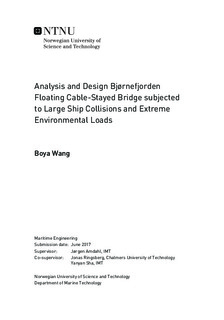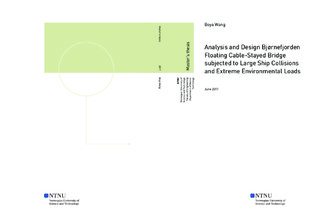| dc.contributor.advisor | Amdahl, Jørgen | |
| dc.contributor.advisor | Ringsberg, Jonas | |
| dc.contributor.advisor | Sha, Yanyan | |
| dc.contributor.author | Wang, Boya | |
| dc.date.accessioned | 2017-09-27T14:01:53Z | |
| dc.date.available | 2017-09-27T14:01:53Z | |
| dc.date.created | 2017-06-11 | |
| dc.date.issued | 2017 | |
| dc.identifier | ntnudaim:17139 | |
| dc.identifier.uri | http://hdl.handle.net/11250/2457148 | |
| dc.description.abstract | The safe pontoon has the additional ring stiffeners and the thicker girders and ring stiffeners as well. The peak forces corresponding to the original pontoon and the proposed pontoon are 26MN and 42MN respectively. The force-deformation curve was obtained by simulating the ship-pontoon collision in LS-DYNA. The force-deformation curve can be divided into two curves, one is for the bulb and one is for the forecastle. Considering the height of the bridge deck in the middle navigation channel, it is practical to use the bulb curve to define the non-linear spring representing the ship.
In terms of the global analysis, the maximum transverse displacement in these cases is 3.5m, which can be considered as a small deflection compared with the length of the bridge. The displacement in USFOS simulation is close to the value obtained from the hand calculation of the single degree of freedom. | |
| dc.language | eng | |
| dc.publisher | NTNU | |
| dc.subject | Maritime Engineering, Ocean Structures | |
| dc.title | Analysis and Design Bjørnefjorden Floating Cable-Stayed Bridge subjected to Large Ship Collisions and Extreme Environmental Loads | |
| dc.type | Master thesis | |

